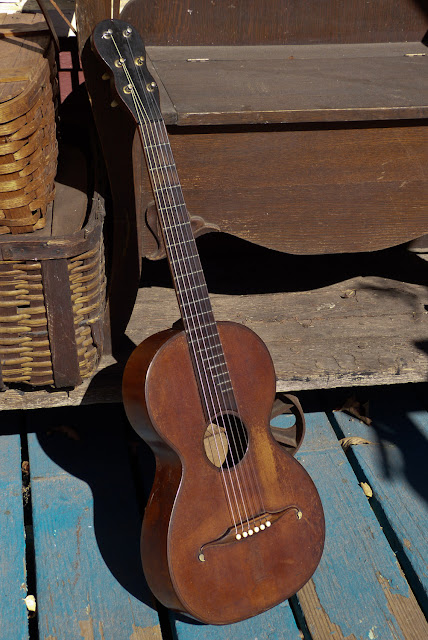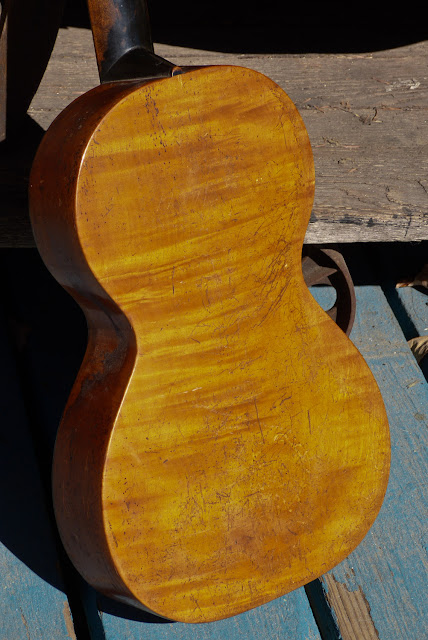1830s German-made Parlor Guitar
I'm fairly sure this guitar dates from anywhere in the 1830s through the 1870s and that it was built in Germany or Austria on the basis of that pretty severe figure-8 body shape, its top bracing pattern, and the material choices. It's weathered the years wonderfully and only has a few side cracks -- all of which were repaired before me. The rest of the wear can be described as due to "regular use."
This little beaut was a repair job for a customer and it's been sitting in my racks forever. The work wasn't so bad -- a refret, some bridge gluing, bridge reprofiling, a new saddle, center-seam cleats, and the addition of 1890s/1900s-era friction pegs -- and the result is a guitar that plays spot-on and has a gorgeous, full (especially for its size) tone. It's currently strung with a set of average nylon strings but would've had gut when it was made.
Unlike many period guitars, the top is quite lightly-built and so the "boxy" sound I associate with similar-looking instruments isn't found on this one. It reminds me a bit of that pseudo-Stauffer I worked on recently (though the bracing is quite different).
This headstock shape was used by many makers at the time and continued as a popular shape through the mid-1800s. The nut is original and ebony -- and it felt like the width was 1 3/4" but with a neck profile that's a quick, modern-ish "C" shape.
The hole at the top of the headstock is also common on period guitars -- bows, ribbons, frilly stuff, flowers, and straps were tied-off with them.
This originally had bar frets but they were very loose, no longer fit nicely in their slots, and weren't practical to re-use. I filled the slots and re-slotted them for use with modern tanged frets. The neck is, fortunately, stable under tension and after a heavy-handed fret level/dress job to dial-out minor inconsistencies in the board, it plays great.
Let's talk wood -- like most guitars of the time the top is solid, tight-grained spruce and the back and sides are figured, solid maple. The neck is maple, too, but was stained black (which has worn off in many parts). The fretboard is also stained-black maple which has worn and the bridge is the same.
The pins are old celluloid ones I had in my parts-bins. This bridge originally had a fret-saddle but it was located incorrectly. I had to reprofile the bridge a little, too, to set the action correctly with a new fret-saddle and clean-up my modifications.
The back has a bit of an arch to it which looks/feels great and adds strength.
Originally the pegs would've been ebony violin-style ones, but I've used some 1890s/1900s Champion-style friction pegs from my parts-bins instead. These are a lot more practical. Note the headstock/neck joint.
The "ice cream cone" heel shape gives quite good fret access.
Pretty, isn't it?














Comments
The bridge (with the hearts), the unusual fret placement up the neck, the neck heel and the material used are identical. Mine however, has the Stauffer styled, ‘Fender-shaped headstock.
Mine also has a partial paper label inside, with a name partially visible that says, ‘W. Van…..I’m hopeful that one day I’ll discover the name of the maker.